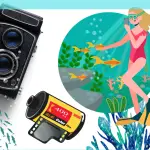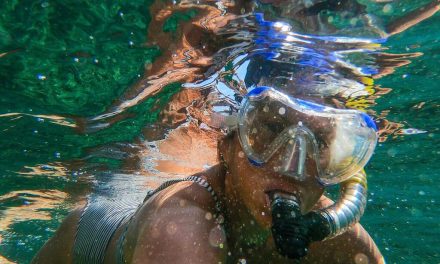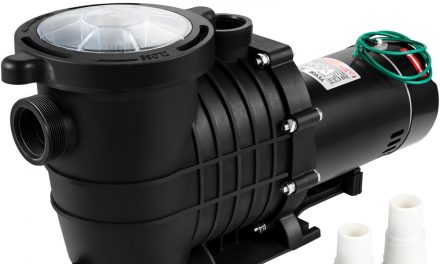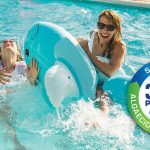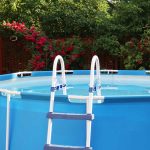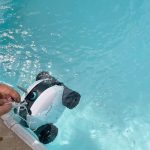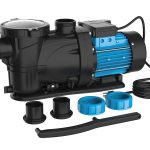Swim lessons can be given by following proper guidelines and techniques. We will explore the steps and tips for giving swim lessons effectively.
Whether you are an experienced swim instructor or a parent teaching your child to swim, these tips will help you provide a safe and productive learning environment. From building trust with the swimmer to breaking down the skills into manageable steps, we will cover all the essential aspects.
By utilizing these strategies, you can ensure that your swim lessons are successful and enjoyable for both the instructor and the learner. So, let’s dive in and discover how to give swim lessons effectively.
Understanding The Basics Of Teaching Swimming
Discover the essentials of teaching swimming and learn effective techniques for giving swim lessons. Develop your skills and knowledge to ensure a safe and enjoyable learning experience for your students.
Teaching swimming skills is an important role that requires expertise, patience, and a deep understanding of the fundamentals. Whether you’re a seasoned swim instructor or just starting out, it’s crucial to grasp the core concepts of teaching swimming before diving into the lessons.
In this section, we will explore the importance of teaching swimming skills, discuss the role of a swim instructor, and highlight the key aspects of creating a safe and supportive learning environment.
Importance Of Teaching Swimming Skills:
- Swimming is a life-saving skill: Drowning is a leading cause of unintentional death worldwide, and learning how to swim greatly reduces the risk of drowning for individuals of all ages.
- Enhances physical fitness: Swimming is a low-impact exercise that offers a full-body workout, improving cardiovascular health, muscular strength, and endurance.
- Builds confidence and self-esteem: Learning to swim empowers individuals, boosting their self-confidence and providing them with a sense of achievement.
- Promotes social interaction: Swimming lessons often take place in a group setting, allowing individuals to develop friendships, teamwork skills, and a sense of belonging within the swimming community.
The Role Of A Swim Instructor:
- Expert guidance: A swim instructor serves as a mentor, offering expert guidance and demonstrating proper swimming techniques.
- Tailored lesson plans: A skilled instructor develops lesson plans suitable for various skill levels, ensuring that learners progress at an appropriate pace.
- Effective communication: Clear and concise communication is essential for a swim instructor to effectively convey instructions, offer feedback, and address any concerns or questions.
- Safety supervision: A swim instructor must prioritize the safety of learners by closely monitoring their progress, identifying potential risks, and implementing appropriate safety measures.
- Encouragement and motivation: A swim instructor plays a vital role in motivating learners, providing encouragement, and helping them overcome challenges or fears associated with swimming.
Creating A Safe And Supportive Learning Environment:
- Clear rules and expectations: Establishing clear and consistent rules for behavior, safety, and participation helps create a structured and secure learning environment.
- Proper equipment and facilities: A swim instructor ensures that learners have access to appropriate swimwear, goggles, flotation devices, and well-maintained swimming facilities.
- Individualized attention: Providing individualized attention to each learner helps address their specific needs, strengths, and weaknesses, facilitating a more effective learning experience.
- Positive reinforcement: Encouraging and acknowledging learners’ accomplishments and efforts through positive reinforcement fosters a supportive and motivating learning atmosphere.
- Building trust and rapport: Developing a trusting relationship with learners promotes open communication and encourages them to ask questions, seek assistance, and take risks in their swimming journey.
Remember, understanding the basics of teaching swimming is the foundation for successful swim lessons. By prioritizing safety, tailoring lessons, and creating a supportive environment, you can ensure a positive and effective learning experience for your students.
Essential Techniques For Effective Swim Instruction
Learn the essential techniques for effective swim instruction with these expert tips. Discover how to give swim lessons and become a skilled swim instructor.
Breaking Down Swimming Strokes Into Manageable Steps
- Teaching swimming strokes can feel overwhelming, but breaking them down into manageable steps makes it easier for both you and your students to grasp. Here’s a step-by-step approach to help you navigate the process:
- Choose the stroke: Begin by selecting the stroke you want to teach, such as freestyle, backstroke, breaststroke, or butterfly. Focusing on one stroke at a time allows for better comprehension and progress.
- Demonstrate and explain: Clearly demonstrate the stroke to your students, illustrating each movement and body position. Use concise explanations and provide visual aids, if available.
- Break it down: Divide the stroke into smaller components and teach them individually. This approach allows students to focus on mastering one aspect before moving on to the next. For example, for freestyle, you can start with arm movements, then progress to kicking, body rotation, and breathing techniques.
- Practice with drills: Implement drills that isolate specific movements and reinforce proper technique. Use a progression of drills that gradually build up to the full stroke. This approach helps students develop muscle memory and encourages correct form.
- Combine the components: Once students have gained proficiency in each component, integrate them into the full stroke. Guide your students through the entire motion, observing and providing feedback on their form.
- Practice and repetition: Consistent practice is crucial for improving swimming skills. Allocate ample time in each lesson for students to practice the stroke, allowing them to reinforce their learning and make gradual improvements.
Remember, patience and positive reinforcement are key to effective swim instruction. Encourage your students to embrace the process and celebrate their progress along the way.
Teaching Proper Body Positioning And Breathing Techniques
- Proper body positioning and breathing techniques are fundamental to efficient and safe swimming. Here are some essential tips to help you teach these crucial aspects:
- Body positioning: Start by explaining the importance of maintaining a horizontal body position in the water. Emphasize the need to keep the body aligned to reduce drag and improve propulsion.
- Floating and gliding: Teach your students how to float and glide on their fronts and backs, emphasizing relaxation and body control. Encourage them to find their balance and become comfortable with the water.
- Head position: Instruct your students to keep their heads aligned with their spines, looking straight down or slightly forward during forward-focused strokes (like freestyle or butterfly). For backstroke, teach them to look up at the ceiling.
- Breathing techniques: Teach students to exhale gradually underwater and inhale quickly when their mouth emerges above the surface. Practice these breathing techniques separately before incorporating them into full stroke movements.
- Timing and coordination: Help your students synchronize their breathing with their strokes. For instance, during freestyle, inhaling while rotating the head to the side allows for better airflow.
- Gradual progression: Introduce breathing techniques gradually, ensuring students have a solid foundation in body positioning and floating before moving on to more advanced skills. Encourage them to practice breathing exercises outside of lessons to improve their lung capacity.
Applying Effective Instructional Cues And Feedback
- Providing clear and effective cues and feedback is essential in swim instruction. Here are some techniques to apply when coaching your students:
- Visual demonstrations: Show your students the correct technique through demonstrations, using yourself or a proficient swimmer as an example. Visual cues help students understand and replicate the desired movements.
- Simple language: Use simple and concise language when giving instructions. Avoid technical terms that may confuse beginners. Focus on describing key movements and positions using clear and relatable terms.
- Positive reinforcement: Encourage and praise your students when they demonstrate improvement or execute a skill correctly. Positive reinforcement boosts confidence and motivation, enhancing the learning experience.
- Real-time feedback: Provide immediate feedback during practice sessions. Correct mistakes or offer tips to help students refine their technique. This form of feedback reinforces learning and helps students make necessary adjustments.
- Individualized instruction: Each student has unique strengths and challenges. Tailor your cues and feedback to suit each student’s needs. Personalized instruction ensures students receive the specific guidance required for their progress.
- Question and answer: Engage with your students by asking questions to gauge their understanding. Encourage them to ask questions as well, fostering a collaborative learning environment.
Remember, effective cues and feedback should motivate, guide, and empower your students to continuously improve their swimming skills. By breaking down strokes, teaching proper body positioning and breathing techniques, and applying personalized instruction, you can create a positive and successful swim instruction experience for your students.
Structuring Swim Lessons For Optimal Learning
Swim lessons can be optimized for learning by implementing effective structuring techniques. With a focus on tailored instruction, progressive skill development, and a supportive learning environment, students can achieve optimal results in their swimming journey.
Assessing swimmer skill levels and setting goals:
- Before designing your swim lesson structure, it is crucial to assess each swimmer’s skill level. Start by having swimmers demonstrate basic skills such as floating, kicking, and arm movements.
- Based on their abilities, categorize swimmers into groups such as beginners, intermediate, or advanced. This will help ensure appropriate lessons for each group.
- Set achievable goals for each swimmer to work towards. These goals can be both short-term and long-term, promoting a sense of progression and accomplishment.
Designing lesson plans based on age and ability:
- Consider the age and ability of the swimmers when creating your lesson plans. Younger children may require simpler and more repetitive skills, while older swimmers can handle more complex techniques.
- Break down the lesson into different components, focusing on specific skills in each session. For beginners, start with basic water safety and gradually introduce fundamental strokes and techniques.
- Ensure that each lesson plan includes a warm-up session, skill practice, and a cool-down period. This structure allows for a well-rounded and comprehensive learning experience.
Incorporating fun and engaging activities to enhance learning:
- Making swim lessons enjoyable is key to keeping students engaged and motivated. Incorporate fun activities and games that encourage learning while having fun in the water.
- Use colorful and interactive equipment like pool noodles, kickboards, and floating toys to make the lessons more exciting.
- Devote a portion of the lesson to group activities and challenges. This fosters teamwork, builds confidence, and adds an element of friendly competition.
Remember, structuring swim lessons for optimal learning involves assessing skill levels, setting goals, designing age-appropriate lesson plans, and incorporating engaging activities. By following these guidelines, you can create an enjoyable and effective learning environment for swimmers of all ages and abilities.
1. Beginner Swim Lessons
Learn how to give beginner swim lessons with this comprehensive guide. Discover the best techniques, tips, and exercises to help your students become confident swimmers.
Introducing Water Familiarity And Overcoming Fear Of Water
Building water familiarity and helping beginners overcome their fear of water is essential for successful swim lessons. Here are a few methods to introduce the concept and ensure a comfortable learning environment:
- Start with a friendly and reassuring Begin by calmly explaining the basics of water safety and the importance of learning to swim. Encourage beginners by emphasizing that swimming can be a fun and rewarding experience.
- Gradual water exposure: Begin by allowing beginners to dip their toes in the water and gradually progress to more substantial immersion. This stepwise approach helps them acclimate to the sensation and temperature of the water.
- Positive reinforcement: Offering encouragement and praise throughout the process helps build confidence and trust. Applaud their efforts and celebrate any progress made, no matter how small.
- Gentle water games and activities: Introduce enjoyable, water-based activities such as blowing bubbles, splashing water, or playing with floating toys. These activities make the learning process more engaging and less daunting.
- One-on-one attention: Providing individual attention to each beginner during the initial stages can help build trust and alleviate anxiety. This approach ensures that they feel supported and safe throughout the lessons.
- Slow and patient progression: Progression should be gradual, focusing on comfort and confidence in the water before moving on to specific skills. Rushing can cause anxiety to resurface and hinder learning.
Remember, creating a supportive and nurturing environment is crucial for beginners to overcome their fear of water and start building a strong foundation for future swimming skills.
Teaching Floating, Kicking, And Arm Movements
Once beginners feel comfortable and confident in the water, it’s time to introduce the fundamental skills of floating, kicking, and arm movements. A step-by-step approach ensures proper technique and successful learning:
- Floating: Teach beginners the importance of being buoyant and relaxed in the water. Demonstrate different floating techniques, such as back floats and front floats, and guide them through the process. Encourage them to practice controlled breathing and keeping their body aligned.
- Kicking techniques: Demonstrate different kicking techniques, such as flutter kicking and dolphin kicking, and explain how these movements help propel them through the water. Provide visual cues and encourage them to maintain proper leg position and rhythm.
- Arm movements: Teach beginners basic arm movements, such as alternating arm strokes and simultaneous arm movements. Emphasize proper technique, including straight arms, controlled movements, and proper hand positioning. Reinforce the concept of alternating arm movements with coordinated breathing.
- Combined skills: As beginners become more comfortable with floating, kicking, and arm movements individually, gradually combine these skills. Guide them through exercises that integrate all three components, allowing them to experience the sensation of swimming.
Remember, patience and repetition are key when teaching these skills. Each beginner will progress at their own pace, so provide positive reinforcement, feedback, and adjustments as needed. By focusing on mastering these foundational skills, beginners will be ready to progress to basic swimming strokes confidently.
2. Intermediate Swim Lessons
Learn how to give intermediate swim lessons with this comprehensive guide. From teaching technique to safety measures, you’ll gain the skills needed to confidently instruct swimmers at the next level.
Refining Stroke Technique And Timing:
- Focus on technique: Intermediate swim lessons place a strong emphasis on refining stroke technique. This involves helping swimmers become more efficient in the water, improving their body position, and promoting proper arm and leg movements.
- Drills for improvement: To enhance stroke technique, incorporate various swimming drills into the lessons. These drills can target specific aspects of each stroke, such as arm position, body rotation, or kick. By breaking down the movements and practicing them separately, swimmers can develop better form and coordination.
- Timing is everything: Alongside technique, mastering timing is crucial in intermediate swim lessons. Encourage swimmers to synchronize their breathing with their strokes and to maintain a steady rhythm throughout each lap. Proper timing ensures smoother and more efficient swimming.
- Video analysis: Consider using video analysis tools to help swimmers visualize their strokes and understand areas that require improvement. By providing visual feedback, swimmers can take a closer look at their technique, identify any flaws or areas for refinement, and work on making necessary adjustments.
- Feedback and correction: As an instructor, provide continuous feedback to swimmers during their practice. Correct them immediately when you notice any incorrect body movements or stroke technique. Encourage them to self-correct as well, fostering a sense of awareness and accountability.
Introducing Bilateral Breathing And Advanced Swimming Skills:
- Bilateral breathing: In intermediate swim lessons, introduce swimmers to bilateral breathing, which means breathing alternately on both sides during their strokes. Bilateral breathing enhances balance, improves overall body symmetry, and aids in developing a more efficient and effective swimming technique.
- Advanced swimming skills: As swimmers progress, introduce them to advanced swimming skills that build upon their foundation. These skills may include open turns, flip turns, underwater dolphin kicks, or starts off the blocks. Incorporating these skills into their training regimen challenges swimmers and unlocks new levels of performance.
- Training sets: Design training sets that incorporate various drills, techniques, and swimming skills to further enhance proficiency. These sets can involve interval training, where swimmers perform specific distances or repetitions at different intensities to develop endurance, speed, and overall fitness in the water.
- Race preparation: Prepare swimmers for competition by simulating race scenarios during practice. Focus on starts, turns, and maintaining speed over specific distances. Provide tips on strategies for pacing, effective splitting, and building mental resilience, ensuring swimmers are well-prepared for upcoming races.
- Land-based exercises: Supplement swimming lessons with land-based exercises that target core strength, flexibility, and overall conditioning. These exercises support swimmers’ swimming performance by improving stability, power, and body control.
Developing Endurance And Speed In The Water:
- Building endurance: In intermediate swim lessons, gradually increase the training volume to build swimmers’ endurance. Implement longer distance swims and interval sets with shorter rest periods. This progressive approach helps swimmers develop the stamina needed to swim longer distances without compromising their stroke technique.
- Interval training: Incorporate interval training to improve speed in the water. This involves swimming at faster paces for shorter distances with specified rest intervals. By alternating between high-intensity efforts and periods of recovery, swimmers can gradually increase their speed and cardiovascular capacity.
- Progressive overload: Apply the principle of progressive overload to challenge swimmers and facilitate continuous improvement. Gradually increase the intensity, duration, or distance of their training sessions over time. This gradual progression pushes swimmers out of their comfort zone and promotes consistent improvement.
- Variety in training: Vary the training routine by introducing different swimming drills, stroke variations, and training sets. This not only keeps the lessons interesting but also helps swimmers develop adaptability to different swimming conditions and situations they may encounter in competitive swimming.
- Mental preparation: Emphasize mental preparation alongside physical training. Teach swimmers visualization techniques, positive self-talk, and goal-setting strategies to enhance their mental strength and resilience in the water. Developing a strong mindset is crucial for sustained improvement and performance in swimming.
Remember, intermediate swim lessons are all about fine-tuning stroke technique, introducing advanced skills, and developing endurance and speed. By focusing on these elements, swimmers can progress to more advanced levels and enjoy the many benefits of swimming. Happy teaching!
3. Advanced Swim Lessons
Our advanced swim lessons offer a comprehensive approach to teaching swimming techniques. From stroke improvement to diving skills, participants will receive personalized instruction to enhance their abilities in the water.
Perfecting Stroke Technique Through Drills And Repetition
Swimmers at an advanced level require focused training to perfect their stroke technique. By incorporating specific drills and repetitive exercises, instructors can help swimmers refine their form and efficiency in the water. Here are some key ways to enhance stroke technique through drills and repetition:
- Catch-up drill: This drill involves swimming with one arm outstretched while the other arm completes a full stroke, alternating arms with each stroke. It emphasizes proper rotation and the timing of arm movements.
- Fingertip drag: By dragging their fingertips along the water’s surface during the recovery phase, swimmers enhance their arm positioning and minimize unnecessary movements.
- Kickboard drills: Using a kickboard allows swimmers to focus solely on their kicking technique, improving leg strength and body positioning in the water.
- Tarzan drill: In this drill, swimmers keep their heads above water while swimming, similar to the movements made by Tarzan. It helps develop effective body rotation and stamina.
- Drills for specific strokes: Various drills cater to each stroke, such as sculling drills for the butterfly stroke or single-arm drills for the backstroke. These targeted exercises help swimmers master the intricacies of each stroke.
By incorporating these drills and emphasizing repetition, swimmers can refine their stroke technique and become more efficient swimmers.
Teaching Advanced Breathing Techniques And Turns
Breathing technique plays a crucial role in a swimmer’s performance, and advanced swimmers need to fine-tune their breathing patterns to optimize their efficiency in the water. Here are some techniques instructors can teach advanced swimmers regarding breathing:
- Bilateral breathing: Encouraging swimmers to breathe on both sides helps promote balanced muscle development and improves their ability to adapt to different conditions during races.
- Exhalation underwater: In advanced swim lessons, instructors can teach swimmers to exhale continuously while their face is submerged to ensure a more efficient inhalation during the recovery phase.
- Breathing pattern drills: By practicing alternate breathing patterns, such as every 3, 5, or 7 strokes, swimmers can increase their lung capacity and develop better control over their breathing.
In addition to breathing techniques, advanced swimmers also need to master turns for efficient speed and momentum during races. Here are some essential turn techniques to teach advanced swimmers:
- Flip turn: This turn involves executing a somersault while maintaining forward momentum, allowing swimmers to remain underwater longer and have a streamlined push-off from the wall.
- Open turn: Commonly used in freestyle events, the open turn requires swimmers to touch the wall with both hands, execute a quick rotation, and push off with one foot.
- Underwater push-offs: Emphasize the importance of maximizing the distance covered underwater after each turn. Swimmers should focus on dolphin kicks and a streamlined body position to ensure an explosive push-off from the wall.
Through these advanced breathing techniques and turn practices, swimmers will enhance their overall efficiency and speed, preparing them for competitive swimming.
Communication And Safety In Swim Instruction
Learn how to effectively give swim lessons by focusing on communication and safety. Enhance your teaching skills and create a safe learning environment in the water.
Effective Communication Strategies With Learners Of All Ages:
- Use clear and concise instructions to ensure understanding.
- Maintain a positive and encouraging tone to build trust and confidence.
- Adapt your communication style for different age groups, using simpler language for younger swimmers and more detailed explanations for older ones.
- Provide visual demonstrations and cues to reinforce verbal instructions.
- Encourage open communication with learners, allowing them to ask questions and express concerns.
- Break down complex skills into smaller, manageable steps to prevent overwhelm.
- Offer constructive feedback and praise to motivate learners and enhance their progress.
- Be patient and understanding, taking the time to listen and address individual needs and learning styles.
Ensuring Swimmer Safety During Lessons:
- Conduct thorough safety assessments before each lesson, checking the condition of the pool area and equipment.
- Maintain constant supervision of swimmers, remaining vigilant at all times.
- Set clear rules and expectations regarding safety measures, such as no running near the pool and no diving in shallow water.
- Teach swimmers essential water safety skills, including floating on their backs and knowing how to exit the pool safely.
- Stay updated on CPR and first aid techniques, ensuring you can respond quickly in case of emergencies.
- Identify and address potential hazards in the swimming environment, such as slippery surfaces or overcrowded areas.
- Communicate with parents or guardians about any specific health conditions or concerns that may affect a swimmer’s safety.
- Regularly review and reinforce safety guidelines with both swimmers and their parents to prevent accidents.
Identifying And Addressing Common Swim-Related Challenges And Concerns:
- Fear of water: Gradually introduce fearful swimmers to the water, starting with shallow areas and gradually progressing to deeper levels. Use positive reinforcement and encouraging language to build their confidence.
- Breath control issues: Teach proper breathing techniques by emphasizing the importance of exhaling underwater and inhaling when necessary. Practice drills to enhance breath control and increase stamina.
- Lack of coordination: Break down swimming strokes into simpler movements, focusing on one aspect at a time. Utilize visual aids and demonstrations to help swimmers understand and replicate the correct technique.
- Buoyancy and body position: Teach swimmers how to maintain a streamlined body position and proper buoyancy by using flotation devices and practicing floating exercises. Provide feedback and correction to help them improve.
- Stamina and endurance: Gradually increase the duration and intensity of swimming exercises to build up stamina and endurance. Incorporate interval training and distance challenges to push swimmers to their limits and improve their overall fitness.
- Water awareness and spatial orientation: Engage swimmers in activities that improve their understanding of water depth, current, and distance. Practice activities such as diving for objects, swimming underwater, and navigating through obstacles.
- Freestyle breathing challenges: Teach proper bilateral breathing techniques and provide drills to help swimmers overcome the challenge of breathing only on one side. Encourage practice and offer strategies for maintaining a consistent rhythm.
- Continuous assessment and individualized coaching: Regularly assess each swimmer’s progress and identify specific challenges they may face. Tailor instruction and provide personalized feedback to address their unique needs.
Remember, effective communication and safety are key elements in providing successful swim lessons. By employing strategies that cater to learners of all ages, prioritizing safety measures, and addressing common challenges and concerns, you can create a positive and enriching swim instruction environment.
Evaluating Swimmer Progress And Providing Feedback
Evaluate swimmer progress and provide constructive feedback during swim lessons to help learners improve their skills in the water. Expert instructors assess individual strengths and weaknesses, offering tailored guidance and encouragement for optimal development.
Implementing Effective Assessments To Track Swimmer Development:
- Regular assessments play a crucial role in tracking the progress of swimmers. By implementing effective assessment strategies, you can ensure that each swimmer is continually developing their skills, improving their technique, and reaching their goals. Here are some ways to assess and track swimmer progress:
- Set clear criteria: Define specific goals and objectives for each level of swimming. This will help you evaluate swimmers based on specific skills, such as freestyle technique, flip turns, or diving.
- Use a variety of assessment tools: Incorporate different assessment methods, including observation, timed trials, video analysis, and skill-based tests. This will provide a comprehensive view of each swimmer’s performance and highlight areas for improvement.
- Track performance over time: Regularly record and compare swimmers’ progress to identify trends and measure growth. This can be done through simple charts or tracking sheets that document time improvements, skill mastery, or successful completion of specific tasks.
Providing Constructive Feedback To Encourage Improvement:
- Constructive feedback is vital in helping swimmers identify areas for improvement and motivate them to strive for excellence. Here are some tips for giving constructive feedback:
- Focus on strengths and weaknesses: Highlight the swimmers’ strengths to boost confidence while addressing areas that need improvement. By providing constructive feedback on both aspects, you can create a balanced approach that encourages overall growth.
- Be specific and actionable: Give clear, targeted feedback that identifies specific actions or adjustments the swimmer can make to enhance their performance. For example, instead of saying, “Your turn could be better,” provide precise instructions like, “Try extending your arms further during the turn for a more efficient rotation.”
- Use positive reinforcement: Incorporate positive reinforcement when providing feedback. Recognize and acknowledge the swimmers’ efforts, progress, and achievements. This will motivate them to continue their hard work and instill a sense of accomplishment.
Celebrating Achievements And Setting New Goals:
- Celebrating achievements is crucial for recognizing and motivating swimmers. By setting new goals and celebrating milestones, both swimmers and instructors can maintain enthusiasm and progress. Here’s how to celebrate achievements and set new goals:
- Recognize milestones: Celebrate significant accomplishments, such as completing a challenging swim distance or achieving a personal best time. This can be done through certificates, awards, or public recognition within the swim community.
- Reflect on progress: Take the time to reflect on the swimmers’ progress and acknowledge their journey. This can be done through individual or group discussions, allowing swimmers to share their experiences and lessons learned.
- Set new goals: Encourage swimmers to set new goals, helping them continuously strive for improvement and growth. Work together to establish realistic objectives that align with their abilities and aspirations.
By implementing effective assessments, providing constructive feedback, and celebrating achievements, swim instructors can create a positive and motivating environment for swimmers to develop their skills and reach their full potential.
Enhancing Teaching Skills Through Continuous Learning
Enhance your swim teaching skills through continuous learning to become a more effective instructor in the pool. Discover new teaching techniques, stay updated on safety protocols, and improve your communication skills with learners of all ages and abilities.
Swim instructors play a vital role in helping individuals of all ages become confident swimmers. To excel in this profession, it is essential to constantly enhance teaching skills through continuous learning. By staying updated on the latest swimming techniques and methodologies, attending swim instructor workshops and conferences, and establishing a network of fellow swim instructors for knowledge-sharing, instructors can provide the best possible swim lessons.
Here’s how:
Staying Updated On The Latest Swimming Techniques And Methodologies:
- Regularly read swimming journals and articles to stay informed about new teaching strategies.
- Subscribe to reputable swimming blogs or websites that provide valuable insights and updates.
- Follow professional swim instructors or organizations on social media platforms to learn about their best practices and recommendations.
- Keep an eye on any research studies conducted in the field of swimming instruction and incorporate relevant findings into teaching methods.
Attending Swim Instructor Workshops And Conferences:
- Participate actively in swim instructor workshops and conferences to expand knowledge and skills.
- Learn from experienced professionals who share their expertise in teaching techniques, safety measures, and lesson planning.
- Take advantage of hands-on training sessions offered at these events to enhance practical teaching skills.
- Network with fellow instructors to exchange ideas, gain new perspectives, and build connections within the swimming community.
Establishing A Network Of Fellow Swim Instructors For Knowledge-Sharing:
- Join swim instructor groups or forums online to connect with like-minded professionals.
- Engage in discussions on teaching methods, lesson plans, and challenges faced in swim instruction.
- Share personal experiences and seek advice from experienced swim instructors to improve teaching effectiveness.
- Consider forming study groups or small communities of practice where instructors can collaborate and support each other’s professional growth.
Remember, continuous learning is the key to becoming a proficient swim instructor. By staying updated on the latest swimming techniques and methodologies, attending workshops and conferences, and establishing a network of fellow instructors for knowledge-sharing, you can provide superior swim lessons and help individuals become confident and skilled swimmers.
Growing As A Swim Instructor: Building Relationships And Reputation
Gain expertise as a swim instructor by nurturing relationships and building a solid reputation. Discover effective strategies for delivering swim lessons and developing meaningful connections with your students.
Swim instructors not only teach the techniques of swimming, but they also have the opportunity to build lasting relationships with their students and their parents. These relationships are the foundation of a swim instructor’s success and can greatly impact their reputation in the community.
In this section, we will explore how to grow as a swim instructor by focusing on building trust and rapport with swimmers and their parents, developing a positive teaching style and demeanor, and leveraging testimonials and referrals to expand clientele.
Building Trust And Rapport With Swimmers And Their Parents:
- Create a welcoming environment: Make sure your swim lesson area is clean, organized, and inviting. This will help students and their parents feel comfortable and at ease from the moment they arrive.
- Greet everyone with a smile: A warm and friendly greeting can go a long way in building trust and establishing a positive relationship. Show genuine interest in getting to know your students and their parents.
- Communicate effectively: Clearly explain your teaching methods, lesson plans, and expectations to both swimmers and their parents. Open and honest communication will foster trust and help set the stage for a successful learning experience.
- Be patient and empathetic: Every swimmer is unique and may require different levels of time and support. Patience and understanding will help students feel comfortable and allow them to progress at their own pace.
- Provide constructive feedback: Offer praise and constructive criticism in a supportive manner. This will help swimmers feel valued while also giving them guidance on areas for improvement.
Developing A Positive Teaching Style And Demeanor:
- Be enthusiastic and encouraging: Show enthusiasm for swimming and the progress your students are making. Celebrate their achievements and motivate them to continue pushing themselves.
- Adapt to different learning styles: Recognize that each swimmer may have a different learning style. Be flexible in your teaching methods and adapt to meet the needs of each individual student.
- Maintain a calm and positive attitude: Swimmers often look to their instructor for guidance and reassurance. Stay calm and composed, even during challenging moments. A positive attitude can help ease any anxieties and create a more enjoyable learning environment.
Leveraging Testimonials And Referrals To Expand Clientele:
- Request feedback and testimonials: After a swim session or lesson, reach out to parents and ask for their feedback. Positive testimonials can be used to showcase your expertise and build trust with potential clients.
- Encourage word-of-mouth recommendations: Happy parents and students are more likely to recommend your services to others. Provide exceptional swim lessons and foster positive relationships to generate organic referrals.
- Offer referral incentives: Consider offering incentives, such as discounts or free lessons, to current clients who refer new students to you. This can help motivate your existing clientele to spread the word about your swim instruction services.
By focusing on building trust and rapport with swimmers and their parents, developing a positive teaching style and demeanor, and leveraging testimonials and referrals, swim instructors can enhance their reputation and attract new clients. Building strong relationships not only benefits the instructor but also creates a supportive and enriching learning experience for the swimmers themselves.
Conclusion
Mastering the art of giving swim lessons can be a fulfilling and impactful endeavor. By following the steps outlined in this guide, you can ensure that your students have a positive and effective learning experience. Remember to create a safe and supportive environment, tailor your teaching methods to each individual, and focus on building trust and confidence in the water.
Utilize various resources and strategies, such as visual aids and games, to keep your lessons engaging and fun. Continuously evaluate and adjust your approach to meet the needs of your students. As you witness their progress and growth, you will feel the satisfaction of knowing that you have helped them develop a valuable life skill.
So dive in and share your passion for swimming with others, and watch as they become confident and capable swimmers under your guidance.


